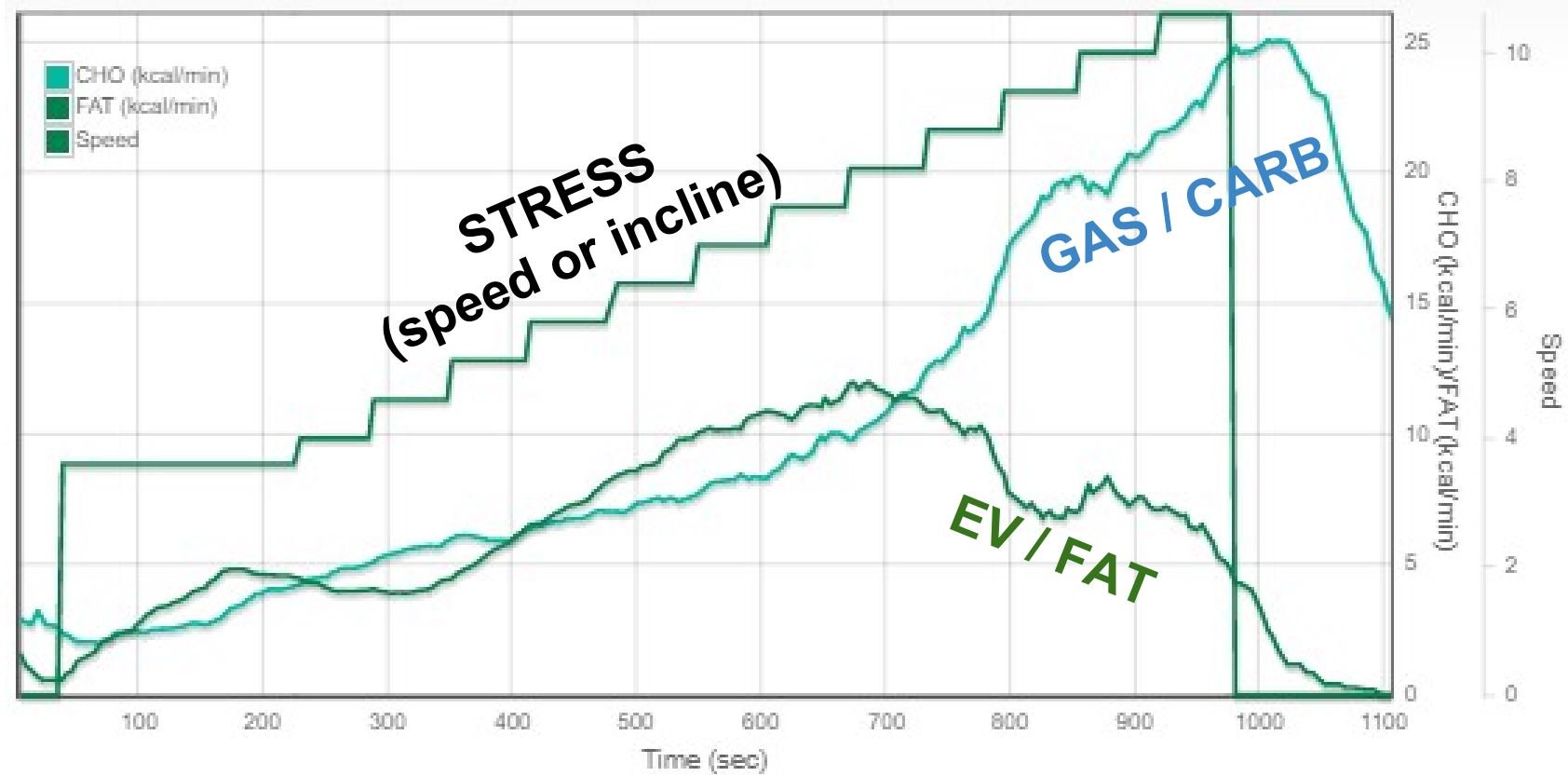Exercise Metabolism: Understanding How You Are A Prius
The way our bodies respond to exercise is best described using a hybrid vehicle.
Our EV engine utilizes oxygen and fat metabolism to produce our lower intensities.
Our gas engine utilizes carbohydrates and produces our high intensities.
Key Takeaways from this Article:
Metabolic “stress tests” aka VO2max Tests are the best way to understand this phenomenon
As physical stress increases, we shift from predominately fat/oxygen (EV) to carbohydrates (gas)
This crossover is termed the “Aerobic Threshold” (AeT)
This demarcates the top of your “Zone 2” heart rate zone and is the empirical way (alongside lactate) to determine it
Having the AeT happen at higher workloads is a hallmark of good health and performance
EV has more range than gas
At the end of this article, we will discuss a field test for determining your Aerobic Threshold
The Prius Analogy to Exercise Metabolism
When driving a hybrid vehicle, EV handles the slower speeds (low intensity) and the gas engine kicks on at higher speeds (high intensity).
The gas engine is a helping hand, meaning that the EV never shuts off. The gas engine is used to meet the demands you are asking when pressing on the gas pedal.
At slower speeds, the gas is on but the contribution is minimal.
“Exercise intensity” here is synonymous with “stress response,” and for the purpose of this article shall be pictured as running/walking on a treadmill.
Increasing intensity/stress is done so by either ramping the incline (constant speed), or ramping the speed (constant incline).
Screenshot from a treadmill VO2max test showing the relative contributions of energy from carbohydrates and fat. The protocol was a constant incline while speed increased 0.6 mph every minute.
Now, we have a finite gas tank, and said gas tank also creates exhaust which we will liken to the burning sensation in our muscles. EV on the other hand, for this example, is for practical reasons, nearly limitless.
Here are the energy sources and their range:
(≈70,000 kcals stored fat - >1000 miles of range)
(≈3,000 kcals stored carbohydrates - 20 miles of range)
So our gas tank is comparatively very small, and creates toxic exhaust- it would be great if we could predominately rely on EV, wouldn’t it?
Striving to do just that is, in essence, the route to optimal health and performance.
Tracking the point of highest EV contribution (fat oxidation), called “FATmax,” and when the crossover to gas occurs, the “aerobic threshold,” is pictured below.
Aerobic Threshold
The aerobic threshold is arguably the most important in aerobic exercise prescription geared towards performance or health. It’s a “threshold” that demarcates for athletes the upper limits of base endurance training (i.e. Zone 2).
For those looking for benefits to health and longevity, this threshold guides us on how easy you can exercise and still reap some massive adaptations in metabolic health.
Unfortunately, most exercisers self-select intensities higher than the threshold for the bulk of their workouts, incurring more fatigue than necessary for the benefit.
There’s an optimal balance between sub- and supra-threshold exercise that is rarely hit.
So how do we begin this process of figuring this out? Ideally, this is performed in the lab to get the beautiful graphs you see above.
Laboratory Testing
From a single 20min treadmill test we’ll have:
An assessment of health and longevity (VO2max; Thresholds; Fatmax)
A prescriptive rubric for future exercise intensity
Information on current metabolic and respiratory health
Information on ventilatory efficiency, lung function and skeletal muscle oxygenation
Pretty powerful stuff!
If You Don’t Have Access to a Lab
If you don't have access to an indirect calorimeter (VO2 device) and still want to understand where this aerobic threshold exists, we can use our perceived levels of breathlessness while we walk/run/cycle.
Here’s what you’ll need:
A heart rate monitor
A treadmill / stationary bike
Memorization of the Pledge of Allegiance
A notepad
To begin, start your watch and your exercise equipment and find a speed/incline/resistance that elicits a heart rate of 100- 110 bpm after 2 minutes of effort. If you are older or have a lower than usual max heart rate, use 80-90bpm.
Once you’ve found this speed, and be careful not to overshoot, begin increasing intensity every 2 minutes:
0.4mph on treadmill or 2% incline
15-30 watts on bike depending on your fitness
Keep your cadence around 80rpms for the entirety
At the 1:30 mark of every stage, write down your heart rate.
At the 1:40 mark, recite the Pledge of Allegiance. This should take you less than 15 seconds. Write down whether or now you can speak comfortably with “Yes,” “Yes, but…” or “No.”
It would be wise to have your notepad pre-filled with the stage numbers and a place to write your comments and heart rates. Optimally, you will have your starting intensity and the protocol you're using.
Once you have recorded a “No,” you can stop the test.
Whatever your heart rate was when you recorded your “Yes, but” answer is around the time of your Aerobic Threshold, or when you are beginning to use more gas to manage the difficulty of exercise. Regular exercise at this threshold can lead to significant metabolic benefits.
This can happen between 75%-85% of your max heart rate, so use this as a “sniff” test in case you get wildly different numbers.
And there you have it, a field test to determine your zone 2 heart rate reliant specifically on your unique physiologic performance!
Conclusion
Hopefully this sheds some light on how our metabolism functions during graded exercise. Using the Prius analogy is very general, but it is extremely helpful in broaching the subject of how our bodies respond to stress.
From this understanding, you can bridge off into separate disciplines in health and performance, such as training intensity, fueling for performance, and exercising for optimal health and longevity.


